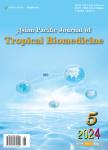Larvicidal activities of chinaberry,neem and Bacillus thuringiensis israelensis(Bti) to an insecticide resistant population of Anopheles arabiensis from Tolay,Southwest Ethiopia
Larvicidal activities of chinaberry,neem and Bacillus thuringiensis israelensis(Bti) to an insecticide resistant population of Anopheles arabiensis from Tolay,Southwest Ethiopia作者机构:Department of MedicineCollege of Medicine and Health SciencesAmbo University Aklilu Lemma Institute of PathobiologyAddis Ababa University Human HealthMalaria Control DepartmentInternational Center of Insect Physiology and Ecology
出 版 物:《Asian Pacific Journal of Tropical Biomedicine》 (亚太热带生物医学杂志(英文版))
年 卷 期:2016年第6卷第7期
页 面:554-561页
核心收录:
学科分类:0710[理学-生物学] 0831[工学-生物医学工程(可授工学、理学、医学学位)] 1004[医学-公共卫生与预防医学(可授医学、理学学位)] 100401[医学-流行病与卫生统计学] 10[医学]
主 题:Larvicide Anopheles arabiensis Tolay Insecticide Resistance Botanical Bio-efficacy
摘 要:Objective:To elucidate the larvicidal potency of neem, chinaberry and Bacillus thuringiensis israelensis(Bti) to larvae of Anopheles arabiensis under semi-field condition and adult susceptibility/resistance to the conventionally used insecticides in Tolay,Southwestern ***: Wild collected 3rd and 4th stage larvae were exposed to neem, and chinaberry seed powder dissolved in water and Bti in artificial containers at three treatment levels:0.2, 0.1 and 0.05 g/m^2 and controls were free of treatments. Larval and pupal mortalities were monitored daily and residual activities were determined. The experiments were replicated three times. The World Health Organization tube test for all classes of insecticides was conducted on adult Anopheles arabiensis reared from field collected larvae and pupae. Data were analyzed using STATA software version ***: In the first application, neem powder caused 88.9%, 87.9% and 79.4% larval and pupal mortality at 0.2, 0.1 and 0.05 g/m^2 after 4.3, 6.0 and 5.7 days, respectively. The corresponding killing effect of chinaberry was 80.3%, 62.1% and 30.3% after 7.0, 7.7 and 8.3days respectively. Bti at all treatments killed 100% after 24 h except 2.7 days for 0.05 g/m^*** mosquitoes were susceptible only for fenitrothion and pirimiphos-methyl with 100%mortality while resistant to deltamethrin, alpha-cypermethrin, etofenprox and dichlorodiphenyl-tricgloroethane with only 9.0%, 3.0%, 5.1% and 2.0% mortalities ***: Neem, chinaberry and Bti showed potent larvicidal and pupicidal activities. However, in the area, high level of mosquito resistance to pyrethroids and dichlorodiphenyl-tricgloroethane was seen which will pose serious challenge to vector control in the future. Therefore, using integrated approach including these botanical larvicides is warranted to manage insecticide resistance.



